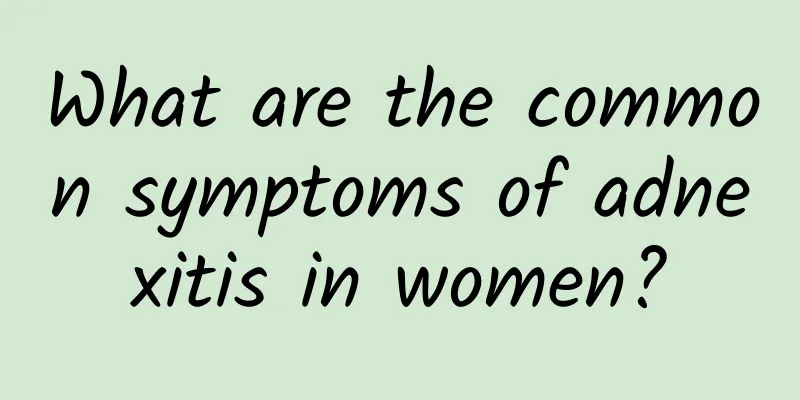How to diagnose acute and chronic pelvic inflammatory disease?

|
Chronic pelvic inflammatory disease and endometriosis are sometimes difficult to distinguish. Endometriosis causes more severe dysmenorrhea. If typical nodules can be felt, it will help with the diagnosis. The occurrence of pelvic inflammatory disease can cause great harm to patients. So how to diagnose acute and chronic pelvic inflammatory disease? Let's take a look at the relevant knowledge about acute and chronic pelvic inflammatory disease. Acute and chronic pelvic inflammatory disease can be diagnosed based on medical history, symptoms and signs. However, differential diagnosis must be done well. The main differential diagnosis of acute pelvic inflammatory disease includes: acute appendicitis, ectopic pregnancy, ovarian cyst pedicle torsion, etc.; the main differential diagnosis of chronic pelvic inflammatory disease includes: endometriosis and ovarian cancer. Acute pelvic inflammatory disease has a history of acute infection, with dull pain in the lower abdomen, muscle tension, tenderness and rebound pain, accompanied by rapid heart rate, fever, and a large amount of purulent vaginal discharge. In severe cases, there may be high fever, headache, chills, loss of appetite, a large amount of yellow leucorrhea with odor, abdominal distension, tenderness, and lower back pain. Nausea, abdominal distension, vomiting, diarrhea, etc. may occur when there is peritonitis. When pus is formed, there may be a lower abdominal mass and local compression and irritation symptoms. If the mass is located in the front, there may be difficulty urinating, frequent urination, and urinary pain. If the mass is located in the back, it may cause diarrhea. The systemic symptoms of chronic pelvic inflammatory disease are sometimes low fever, fatigue, and some patients develop neurasthenia symptoms due to the long course of the disease, such as insomnia, lack of energy, general discomfort, etc. The lower abdomen is swollen, painful, and the lumbar and sacral pain is often aggravated by fatigue, after sexual intercourse, and before and after menstruation. The above is the relevant knowledge of acute and chronic pelvic inflammatory disease. Do you understand it? Chronic inflammation can cause pelvic congestion and menorrhagia. When ovarian function is damaged, menstrual disorders will occur. When the fallopian tubes are blocked by adhesions, it will lead to pelvic inflammatory infertility. If you have any questions about pelvic inflammatory disease, please consult our online experts for answers. Pelvic inflammatory disease http://www..com.cn/fuke/pqy/ |
<<: What are the main aspects of dietary care for ovarian cysts?
>>: What are the symptoms of pelvic inflammatory disease
Recommend
What is the most conservative treatment for uterine fibroids? What is the most conservative treatment for uterine fibroids?
What is the most conservative treatment for uteri...
Is it normal to have pelvic effusion during menstruation? What should patients pay attention to in their diet?
Pathological pelvic effusion can cause great harm...
How to care for cervicitis in women in daily life? Check out 5 principles of cervicitis care
The nursing method for cervicitis is very simple....
Endometriosis Chinese medicine
For women to conceive successfully, many conditio...
To get rid of obesity, you must first eliminate phlegm and dampness! Remember 7 key points to lose weight naturally
Although others are putting in the same effort an...
Yoga exercise for beauty and weight loss is popular all over the world (Part 1)
Yoga is an ancient sport that originated in India...
Daily care for patients with ectopic pregnancy is very important
At present, the occurrence of ectopic pregnancy s...
Analysis of the best treatment for threatened abortion
Threatened abortion is a disease unique to pregna...
How to understand the clinical symptoms of bacterial vaginosis
What are the common symptoms of bacterial vaginos...
Self-massage therapy for irregular menstruation
Menstrual irregularities include early, late or i...
What are the dietary taboos for women with irregular menstruation? What causes irregular menstruation in women?
Menstrual disorders, also known as irregular mens...
Can’t control your eating? 11 foods to help reduce appetite
Looking at the skinny female stars on TV and the ...
What to do if you have a headache after miscarriage? There are 6 ways
If you have a headache after miscarriage, you mus...
How to treat cervical erosion in women? Take four measures to effectively prevent cervical erosion
The data of female cervical cancer is increasing ...
What are the dietary treatments for irregular menstruation?
Irregular menstruation is a common disease for mo...









